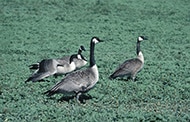While this ability to thrive is good for the goose, it can sometimes lead to landowner frustration during the summer, when geese begin to molt. The Georgia Department of Natural Resources’ Wildlife Resources Division (WRD) asks people to be patient with geese during this time of year.
“Each summer, in late June and early July, geese go through a molting process during which they lose their flight feathers and are in the process of growing new ones,” says WRD State Waterfowl Biologist Greg Balkcom. “We find that it is typically this time of year that the most complaints about goose feces and feathers are reported.”
What can you do if you have goose problems? During most times of the year, geese can be scared away with the use of harassment techniques. But, because geese cannot fly during the molt, these techniques may not work. During the molting season, WRD personnel encourage affected landowners and homeowners to be patient. The new feathers will soon grow in, and the geese will regain their ability to fly and will likely move on.
However, if geese continue to cause problems, here are a few tips to try and reduce the trouble:
• Harassment: Landowners who don’t want geese on their property can first try a variety of harassment techniques, including chemical repellents, mylar balloons, wire/string barriers, and noise makers. These methods are proven to help reduce goose problems. However, they require consistency from the property owner and are not always 100% effective.
• Relocation or Lethal Methods: Homeowners who want to reduce or eliminate the goose population on their property can obtain a permit from their local WRD Game Management office (www.georgiawildlife.com/about/contact). This permit allows them to have geese captured and relocated to a suitable area or allows them to legally and lethally remove the animals. The removal can be done by the homeowner or by a licensed nuisance wildlife trapper (list found at www.georgiawildlife.com/nuisancewildlife).
It is important to remember that Canada geese are a protected species under state and federal law. It is illegal to hunt, kill, sell, purchase or possess Canada geese except according to Georgia’s migratory bird regulations.
For more information, visit www.georgiawildlife.com (Select “Hunting”, “Game Management” and “Nuisance Canada Geese”).
(June 21, 2017)


